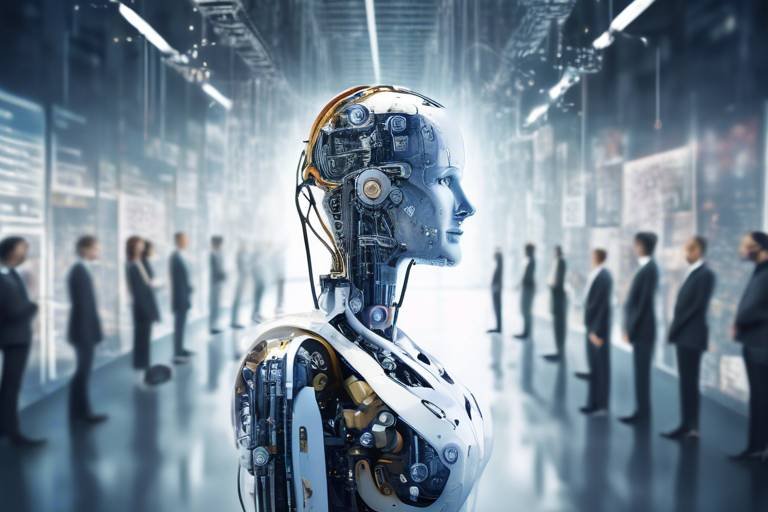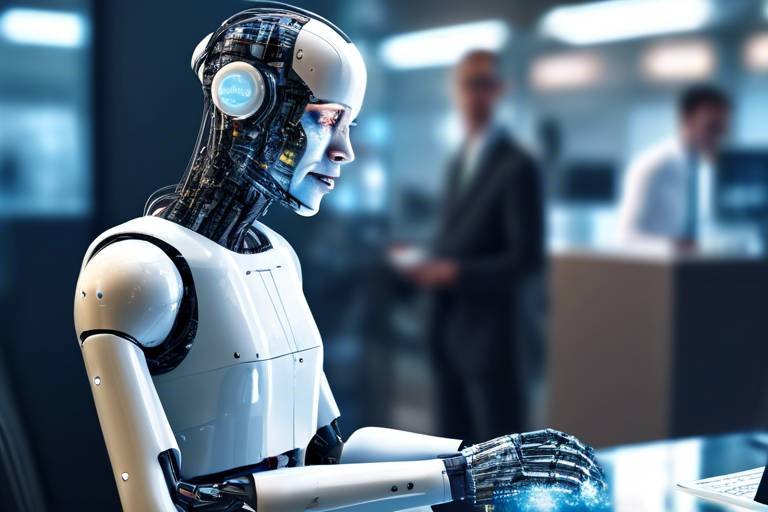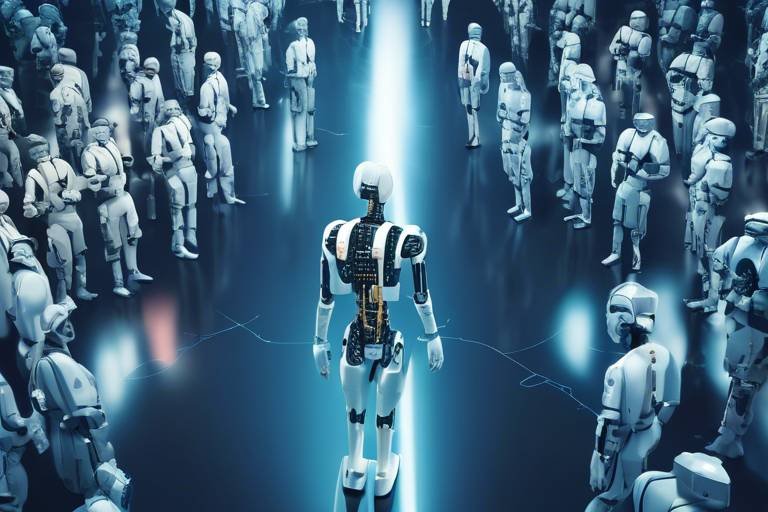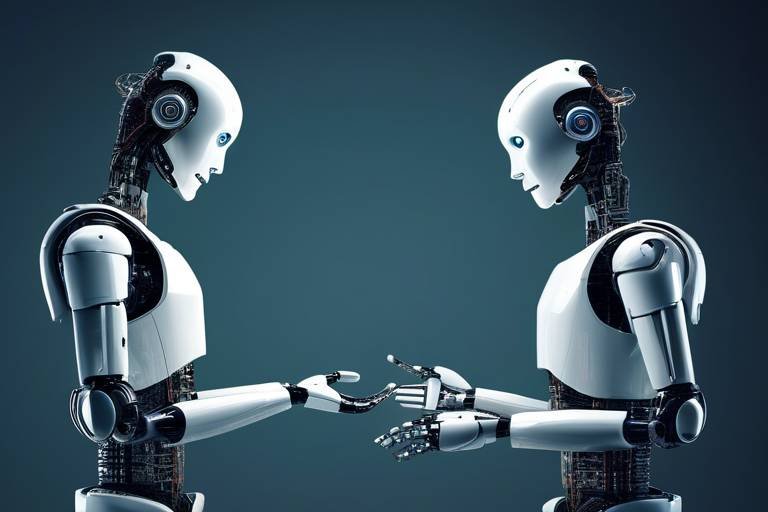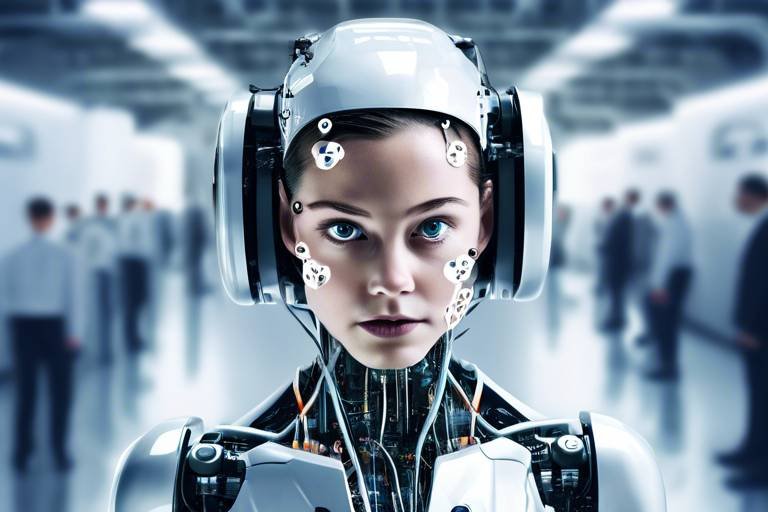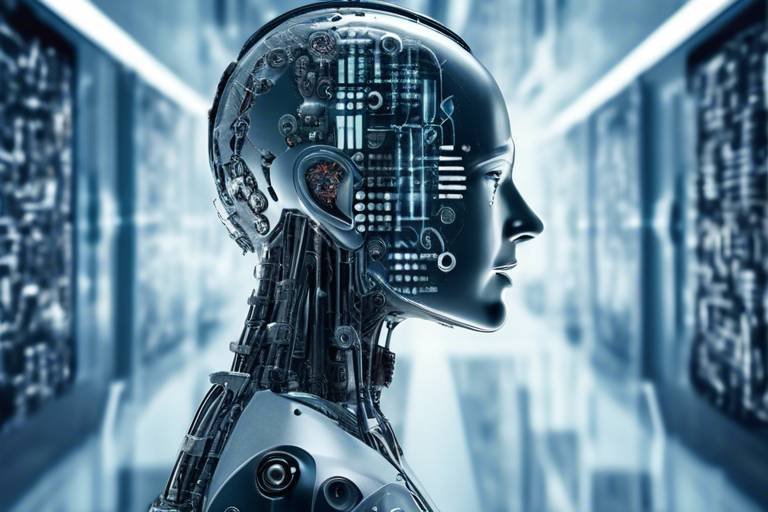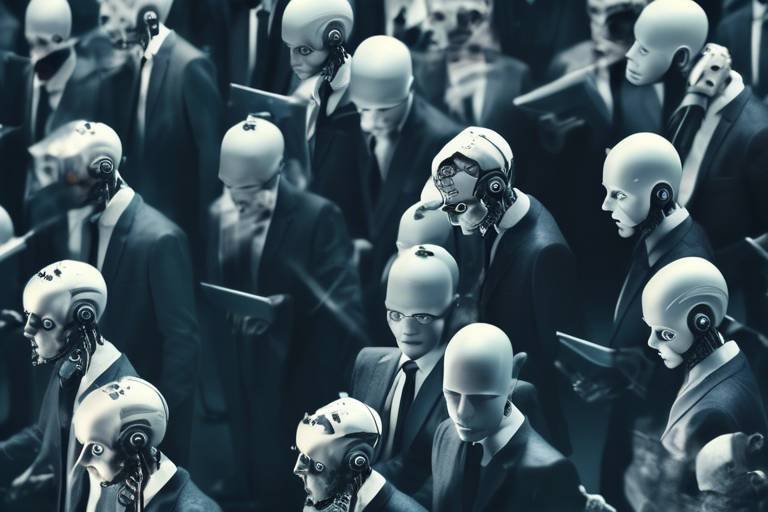Preparing for a Future Dominated by AI and Automation
As we stand on the brink of a new era, it's hard not to feel a mix of excitement and concern about the rapid advancements in artificial intelligence (AI) and automation. These technologies are not just buzzwords; they are reshaping our world in profound ways. Imagine a landscape where machines not only assist us but also take on tasks that were once considered uniquely human. It’s like living in a sci-fi movie, isn't it? But beyond the shiny gadgets and futuristic visions, there lies a pressing need for all of us to adapt and prepare for the changes that are coming our way.
The implications of AI and automation stretch across various sectors, from healthcare to manufacturing, and even into our everyday lives. As these technologies continue to evolve, understanding their transformative effects becomes crucial. Are we ready to embrace this change, or will we be left behind in a world that is moving at lightning speed? The truth is, the future will demand more from us than ever before. We will need to be flexible, strategic, and most importantly, prepared.
In this article, we will explore the implications of AI and automation on different industries, the impact on job markets, and the skills needed to thrive in this new landscape. We’ll dive into the challenges of job displacement while also shining a light on the new opportunities that are emerging. It's a journey that requires a proactive approach, and it starts with understanding the changes that are already underway.
Are you ready to take the plunge? Let’s navigate this uncharted territory together and equip ourselves for a future that is not just automated, but also filled with potential.
The rise of AI and automation is not a distant reality; it’s happening right now. Technologies like machine learning, robotics, and natural language processing are advancing at a breakneck pace, fundamentally altering how industries operate. Just think about how online shopping has transformed retail or how AI-driven algorithms are changing the way we consume news and entertainment. These changes are not just superficial; they are reshaping the very fabric of our economy.
Consider this: a recent study indicated that by 2030, up to 800 million jobs could be displaced globally due to automation. That's a staggering number! But it’s not all doom and gloom. While some jobs may vanish, new roles are emerging that we could hardly have imagined a decade ago. The key takeaway here is that understanding these changes is vital for future preparedness. The sooner we start adapting, the better equipped we will be to thrive in this new digital landscape.
With the rapid rise of AI and automation, the job market is undergoing a seismic shift. While some sectors are experiencing significant job displacement, others are witnessing the birth of entirely new roles. It’s a classic case of creative destruction—as old jobs fade away, new opportunities arise. But what does this mean for you? It means that the workforce must adapt and reskill to meet evolving demands.
One of the most pressing concerns surrounding AI and automation is job displacement. It’s natural to feel anxious about losing your job to a machine, but which sectors are most vulnerable? Industries like manufacturing, transportation, and customer service are among the hardest hit. As companies turn to automation to cut costs and improve efficiency, many workers find themselves facing uncertainty.
Let’s take a closer look at the industries experiencing significant disruption:
| Industry | Impact of Automation |
|---|---|
| Manufacturing | Increased use of robots for assembly lines, leading to reduced labor needs. |
| Transportation | Rise of autonomous vehicles, threatening jobs for drivers. |
| Customer Service | Chatbots and AI-driven support systems replacing human representatives. |
So, what can be done to mitigate the effects of job displacement? It starts with a collaborative effort between policymakers, educational institutions, and businesses. Here are some strategies:
- Policy Development: Governments need to create policies that support workers in transition.
- Education and Training: Implementing programs that focus on reskilling and upskilling.
- Support Systems: Establishing safety nets for those affected by job losses.
While the fear of job loss looms large, it’s essential to recognize the new opportunities that AI and automation present. Roles in tech, data analysis, and AI maintenance are on the rise. These positions require a unique blend of technical skills and creativity, making them exciting prospects for those willing to adapt.
The future workforce will need a diverse set of skills to thrive in an AI-driven economy. This means not only technical skills but also soft skills that enhance our human touch. Continuous learning will be key to staying competitive in this evolving job landscape.
Technical skills like programming, data analysis, and machine learning will be paramount. Those who invest time in acquiring these skills will have a significant advantage in the job market. Educational institutions and online platforms are stepping up to provide resources for individuals eager to learn.
But let’s not forget about soft skills! In a world dominated by technology, attributes like creativity, problem-solving, and emotional intelligence will be invaluable. These skills complement technical abilities and allow us to navigate complex human interactions effectively.
Q: Will AI take away all jobs?
A: While AI will automate certain tasks, it will also create new opportunities that require human skills.
Q: How can I prepare for the changes brought by AI?
A: Focus on reskilling and developing both technical and soft skills to stay competitive.
Q: Which industries are most likely to grow due to AI?
A: Industries like technology, healthcare, and data analysis are expected to see significant growth.

The Rise of AI and Automation
The world is witnessing an unprecedented surge in the development and implementation of artificial intelligence (AI) and automation technologies. These advancements are not merely trends; they are reshaping the very fabric of our industries and our daily lives. Imagine a world where machines can perform tasks with greater efficiency and accuracy than humans. Sounds like science fiction, right? But it’s happening right now! From self-driving cars to chatbots managing customer service inquiries, AI and automation are revolutionizing how we work, communicate, and live.
As we dive deeper into this technological revolution, it’s essential to grasp the magnitude of these changes. The implications extend beyond mere efficiency gains; they pose significant challenges and opportunities across various sectors. For instance, the manufacturing industry has seen robots taking over repetitive tasks, allowing human workers to focus on more complex and creative aspects of production. Similarly, in healthcare, AI systems are now assisting in diagnosis and patient management, leading to faster and more accurate treatment plans. This transformation is not just about replacing human labor; it’s about augmenting our capabilities and redefining our roles in the workforce.
However, with great power comes great responsibility. Understanding these technological changes is crucial for anyone looking to thrive in the future job market. Here are some key areas to consider:
- Technological Advancements: The speed at which AI and automation technologies are evolving is staggering. From machine learning algorithms to robotic process automation, the landscape is continuously changing.
- Industry Disruption: Sectors like retail, finance, and healthcare are experiencing significant shifts. Companies that adapt quickly to these changes can gain a competitive edge.
- Workforce Transformation: As traditional roles evolve, there’s a growing need for workers to reskill and upskill to remain relevant in their jobs.
Moreover, it’s not just about the technology itself; it’s about how we, as a society, choose to integrate these advancements into our lives. The conversation around AI and automation often raises ethical questions regarding privacy, job security, and the potential for widening economic disparities. How can we ensure that these technologies benefit everyone, rather than just a select few? This is where strategic planning and policy-making come into play. Governments, businesses, and educational institutions must collaborate to create frameworks that support workers through this transition.
In summary, the rise of AI and automation is a double-edged sword. It presents incredible opportunities for innovation and efficiency, but it also challenges us to rethink our roles and responsibilities in the workforce. By understanding these changes and preparing for them, we can harness the power of technology to create a brighter future for all.
Q: What is AI?
A: Artificial Intelligence refers to the simulation of human intelligence processes by machines, especially computer systems. These processes include learning, reasoning, and self-correction.
Q: How is automation different from AI?
A: Automation refers to the use of technology to perform tasks without human intervention, while AI involves machines that can learn and adapt. Automation can be simple, like assembly line robots, while AI can involve complex decision-making processes.
Q: Will AI take away all jobs?
A: While AI and automation may displace certain jobs, they also create new opportunities in emerging fields. The focus should be on reskilling and adapting to these changes.

Impact on Job Markets
The advent of AI and automation is not just a passing trend; it’s a seismic shift that’s reshaping the very fabric of job markets across the globe. As we witness these technologies infiltrate various sectors, it’s crucial to recognize the dual-edged sword they present. On one hand, they promise increased efficiency and productivity; on the other, they pose significant challenges to existing job roles. So, what does this mean for the workforce? It’s a complex scenario that requires careful navigation.
First, let’s talk about job displacement. Many workers are understandably anxious about the possibility of losing their jobs to machines. Industries that rely heavily on repetitive tasks are particularly vulnerable. For instance, manufacturing and transportation sectors are already seeing the impact of robotics and automated systems. But it’s not just the blue-collar jobs at risk; even white-collar positions, such as those in customer service and data entry, are being threatened by AI technologies that can handle inquiries and process information faster than any human.
However, it's essential to consider the flip side of this coin. While some jobs will inevitably vanish, new roles are emerging that didn’t exist a decade ago. The demand for data analysts, AI specialists, and robotic technicians is on the rise, creating a landscape where adaptability is key. This shift necessitates a workforce that is not only skilled but also versatile and willing to learn. Companies are looking for individuals who can navigate this new terrain, which means now is the time for workers to invest in their education and skill development.
To better understand the impact of AI and automation on job markets, let’s take a look at a table summarizing some key statistics:
| Sector | Job Displacement Risk (%) | New Job Opportunities (%) |
|---|---|---|
| Manufacturing | 60 | 20 |
| Transportation | 50 | 15 |
| Customer Service | 40 | 10 |
| Tech and Data Analysis | 10 | 50 |
This table illustrates that while certain sectors face a high risk of job displacement, others, particularly in technology, are experiencing growth. The challenge lies in transitioning workers from declining sectors to those that are expanding. This is where reskilling and upskilling come into play. Workers must embrace lifelong learning to stay relevant in a rapidly changing job market.
Moreover, the socio-economic implications of these changes are profound. Communities that rely heavily on industries facing automation may experience economic downturns, leading to increased unemployment rates and social unrest. It’s not just about individual job loss; it’s about the collective impact on families and communities. Policymakers, educators, and businesses must collaborate to create pathways for affected workers, ensuring that no one is left behind in this transition.
In summary, the impact of AI and automation on job markets is significant and multifaceted. While there are undeniable risks associated with job displacement, there are also opportunities for growth and innovation. The key takeaway? Adaptability and continuous learning are essential for thriving in this new landscape. Embracing change rather than resisting it will be crucial for both individuals and organizations looking to succeed in an increasingly automated world.
- Will AI take away all jobs? Not all jobs will be lost, but many will change. New roles will emerge that require different skill sets.
- What can I do to prepare for the future job market? Focus on reskilling and upskilling, especially in technology and soft skills.
- Are there specific industries that will grow due to AI? Yes, sectors like tech, data analysis, and AI maintenance are expected to see significant growth.

Job Displacement Concerns
The rise of AI and automation has sparked significant concerns regarding job displacement, and it's a topic that deserves our attention. As machines and algorithms become more capable, many workers fear for their job security. It's not just a matter of robots taking over; it's about the profound shift in how we work and the skills we need to thrive. The reality is that while some jobs may vanish, others will evolve, and new opportunities will emerge. But first, we need to understand which sectors are most vulnerable to these changes.
Industries such as manufacturing, transportation, and customer service are at the forefront of this transformation. In manufacturing, for instance, robots are increasingly taking over repetitive tasks, leading to a decline in traditional assembly line jobs. According to recent studies, up to 30% of jobs in manufacturing could be automated within the next decade. Similarly, in transportation, self-driving vehicles are on the horizon, threatening the livelihoods of truck drivers and delivery personnel. The implications of these shifts are not just economic; they can disrupt entire communities and lead to increased inequality.
Moreover, the socio-economic implications are staggering. Workers displaced by automation may struggle to find new employment, especially if they lack the skills required for emerging roles. This creates a cycle of unemployment and underemployment that can affect entire families and communities. The fear of job loss can also lead to mental health issues, as individuals grapple with uncertainty about their future. It's essential to address these concerns proactively, ensuring that workers are not left behind in this rapidly changing landscape.
To better understand the impact of automation on job displacement, consider the following table that outlines the percentage of jobs at risk in various sectors:
| Industry | Percentage of Jobs at Risk |
|---|---|
| Manufacturing | 30% |
| Transportation | 25% |
| Customer Service | 20% |
| Retail | 15% |
While these statistics can be alarming, it's crucial to remember that not all change is negative. The key lies in how we respond to these challenges. We need to foster a culture of adaptability and resilience among workers. This involves investing in education and training programs that equip individuals with the necessary skills to transition into new roles. By focusing on workforce development, we can mitigate the effects of job displacement and create a more inclusive economy.
In conclusion, while job displacement due to AI and automation is a legitimate concern, it also presents an opportunity for growth and transformation. By understanding the risks and preparing adequately, we can navigate this new landscape together. Now, let's address some frequently asked questions regarding job displacement and automation.
- What are the main industries affected by automation? Industries such as manufacturing, transportation, and customer service are experiencing the most significant disruptions.
- How can workers prepare for job displacement? Workers can prepare by acquiring new skills through education and training programs that focus on emerging technologies.
- Will new jobs be created as a result of automation? Yes, while some jobs may disappear, automation will also create new opportunities in fields like tech and data analysis.

Industries Most Affected
The rapid advancement of AI and automation technologies is not just a passing trend; it’s a seismic shift that is reshaping the very fabric of various industries. Think of it like a tidal wave, sweeping through sectors and leaving a trail of transformation in its wake. Some industries are feeling the brunt of this change more than others, and it’s crucial to understand which ones are most affected to prepare for the future.
One of the first industries that comes to mind is manufacturing. Traditionally reliant on human labor, manufacturing has seen a surge in automation, with robots now performing tasks that once required skilled workers. This shift has led to increased efficiency and productivity, but it also raises concerns about job displacement for factory workers. As machines take over repetitive tasks, the need for human labor diminishes, forcing workers to adapt or risk being left behind.
Another significant sector experiencing disruption is transportation. With the advent of self-driving vehicles and advanced logistics systems, the landscape of transportation is changing dramatically. Truck drivers, taxi operators, and delivery personnel are facing the possibility of job loss as companies invest in autonomous technologies. The implications extend beyond individual jobs to entire communities that rely on these roles for economic stability.
Customer service is yet another area where AI is making a significant impact. Automated chatbots and virtual assistants are increasingly handling customer inquiries, providing 24/7 support without the need for human intervention. While this enhances efficiency and reduces operational costs for businesses, it also threatens the jobs of customer service representatives. The challenge here is not just the loss of jobs but also the shift in how companies interact with their customers.
To put things into perspective, let’s take a look at a table summarizing the industries most affected by AI and automation:
| Industry | Impact of AI and Automation | Job Roles Affected |
|---|---|---|
| Manufacturing | Increased automation of production lines | Assembly line workers, quality control inspectors |
| Transportation | Rise of autonomous vehicles | Truck drivers, taxi drivers, delivery personnel |
| Customer Service | Use of chatbots and AI-driven support | Customer service representatives, call center agents |
| Retail | Automation in inventory management and checkout | Cashiers, stock clerks |
As we can see, the impact of AI and automation is widespread, affecting various sectors in profound ways. The socio-economic implications of these changes are significant, as communities that rely heavily on these jobs face challenges in terms of employment and economic stability. It’s essential for both workers and policymakers to recognize these trends and develop strategies to address the potential fallout.
In conclusion, understanding which industries are most affected by AI and automation is vital for preparing for the future. By recognizing the challenges and opportunities that lie ahead, we can better equip ourselves to navigate this new landscape and ensure that we are not just passive observers but active participants in shaping a resilient workforce.
- What industries are most likely to be affected by AI and automation?
Industries such as manufacturing, transportation, customer service, and retail are experiencing significant disruption due to AI and automation technologies. - How can workers prepare for the changes brought by AI?
Workers can focus on reskilling and upskilling, particularly in technical and soft skills, to remain competitive in the job market. - Will new job opportunities emerge as some jobs are automated?
Yes, while some jobs may be displaced, new roles in tech, data analysis, and AI maintenance are expected to emerge, requiring a different set of skills.

Strategies for Mitigation
As we navigate the tumultuous waters of an AI and automation-driven future, it's crucial to adopt that can help cushion the blow of job displacement and foster resilience among workers. The key lies in a multi-faceted approach that involves collaboration between governments, educational institutions, and private sectors. Together, they can create a robust framework that supports affected workers while embracing the opportunities that new technologies present.
One of the most effective strategies is investing in education and training programs. This means not just focusing on the technical skills that are in high demand but also integrating soft skills training into the curriculum. For instance, schools and universities should emphasize critical thinking, creativity, and emotional intelligence, which are crucial in a landscape dominated by machines. Reskilling initiatives can take many forms, including online courses, workshops, and partnerships with tech companies to provide hands-on training experiences.
Moreover, governments can play a significant role by implementing policies that promote workforce transition. This could involve financial support for displaced workers, such as unemployment benefits or stipends for retraining programs. Additionally, tax incentives for companies that invest in employee reskilling can encourage businesses to take a more active role in workforce development. By creating a safety net, we can help workers feel more secure as they transition to new roles.
Another strategy involves fostering a culture of lifelong learning. In today's fast-paced world, the ability to continuously adapt and learn is invaluable. Organizations can encourage this mindset by providing resources for employees to pursue ongoing education, whether through formal classes or self-directed learning. By prioritizing a culture of growth, companies not only enhance their workforce's capabilities but also increase employee satisfaction and retention.
To illustrate the importance of these strategies, consider the following table, which outlines key strategies for mitigating the impact of AI and automation:
| Strategy | Description |
|---|---|
| Education and Training | Investing in comprehensive programs that teach both technical and soft skills. |
| Government Policies | Implementing supportive policies and financial aid for displaced workers. |
| Lifelong Learning | Fostering a culture that encourages continuous education and skill development. |
Lastly, it’s essential to engage in community outreach and awareness campaigns. By informing communities about the changes brought by AI and automation, we can prepare them for the future. This involves not only educating the public about potential job losses but also highlighting emerging opportunities. Workshops, seminars, and informational sessions can empower individuals to take proactive steps towards their career paths.
In summary, the strategies for mitigating the impact of AI and automation are not just about addressing current challenges but also about paving the way for a more resilient workforce. By investing in education, implementing supportive policies, and fostering a culture of lifelong learning, we can ensure that workers are not left behind in this rapidly evolving landscape.
- What are the most effective ways to reskill workers affected by automation? Investing in targeted training programs that combine technical and soft skills is crucial.
- How can governments support displaced workers? By providing financial aid and creating policies that encourage reskilling and job transition.
- Why is lifelong learning important in an automated world? Continuous learning helps individuals adapt to new technologies and maintain their employability.

Emerging Job Opportunities
As we navigate through the evolving landscape shaped by AI and automation, it's important to recognize that while some jobs may fade away, new and exciting opportunities are emerging. The rapid advancement of technology is not just a threat; it’s also a catalyst for innovation and growth in various sectors. Imagine a world where your job revolves around maintaining the very systems that once threatened your livelihood. This is the reality many are stepping into, and it’s crucial to be prepared!
One of the most significant areas witnessing job creation is in the realm of technology. Positions such as AI specialists, data scientists, and machine learning engineers are in high demand. These roles require a blend of technical expertise and analytical skills, allowing individuals to work directly with the technologies that are reshaping our world. For instance, AI specialists are responsible for developing algorithms that enable machines to learn and adapt, while data scientists analyze vast amounts of data to inform strategic decisions.
Furthermore, the need for AI maintenance roles is on the rise. As businesses increasingly rely on automated systems, they require skilled professionals to ensure these systems run smoothly. This includes AI trainers, who are tasked with teaching AI systems how to perform specific tasks accurately, and ethics compliance officers, who ensure that AI systems operate within legal and ethical boundaries. The emergence of these roles highlights an essential shift towards a more responsible and sustainable approach to technology.
In addition to technical roles, there’s a growing demand for creative professionals who can bridge the gap between technology and human experience. For example, UX/UI designers are vital in creating user-friendly interfaces for AI applications, ensuring that technology is accessible and enjoyable for everyone. This blend of creativity and technical knowledge is becoming increasingly valuable as companies strive to enhance user engagement and satisfaction.
As we consider the future job market, it’s also important to highlight the opportunities in sectors like healthcare and education. In healthcare, roles such as health informatics specialists are emerging, focusing on the integration of AI in patient care and data management. Similarly, educators are needed to teach the next generation about AI, ensuring that they are equipped with the necessary skills to thrive in this new environment.
To sum it up, while the rise of AI and automation may seem daunting, it is also paving the way for a plethora of new job opportunities. The key to thriving in this new landscape lies in adaptability and a commitment to continuous learning. By embracing change and acquiring the necessary skills, individuals can position themselves at the forefront of this technological revolution.
- What are the top emerging job roles due to AI?
Some of the top roles include AI specialists, data scientists, machine learning engineers, and UX/UI designers.
- How can I prepare for a career in AI?
Focus on developing technical skills such as programming and data analysis, and consider enrolling in relevant courses or certifications.
- Are there opportunities in non-technical fields?
Absolutely! Roles in healthcare, education, and creative industries are also expanding due to the influence of AI.

Skills for the Future Workforce
As we navigate through this exciting yet daunting era of AI and automation, one thing becomes crystal clear: the skills we possess today may not be enough for tomorrow's job market. It's like preparing for a marathon without training – you might make it a few miles, but eventually, you'll find yourself out of breath. To truly thrive in an AI-driven economy, we need to arm ourselves with a diverse arsenal of skills that not only include technical know-how but also the ability to adapt and innovate.
First and foremost, technical skills are becoming increasingly vital. Think about it: almost every industry is now integrating technology in some form. Whether it’s programming, data analysis, or machine learning, having a solid foundation in these areas can significantly boost your employability. The beauty of technical skills is that they are often quantifiable; you can measure your proficiency through certifications, projects, and even online courses. For example, platforms like Coursera and Udacity offer specialized courses that can help you build these skills from the ground up.
However, it's not just about crunching numbers or writing lines of code. The importance of soft skills is also skyrocketing. In a world where machines can perform tasks with precision, what sets humans apart is our creativity, problem-solving abilities, and emotional intelligence. These are the traits that machines simply cannot replicate. Imagine a situation where a team is brainstorming ideas for a new product. While AI can analyze data and suggest trends, it takes a human touch to think outside the box and come up with innovative solutions that resonate with consumers. Thus, cultivating these soft skills is equally crucial for anyone looking to stay relevant in the workforce.
Moreover, the concept of continuous learning cannot be overstated. The pace at which technology is evolving means that what you learn today might become obsolete tomorrow. It’s like trying to catch a train that’s always moving forward – if you stop learning, you risk being left behind. Embracing a mindset of lifelong learning will not only keep your skills fresh but also make you more adaptable to change. Whether it’s attending workshops, enrolling in online classes, or simply reading up on the latest industry trends, staying informed is key.
In addition to these skills, it’s essential to foster a culture of collaboration and teamwork. As projects become more complex, the ability to work well with others will become a significant asset. Companies are increasingly seeking individuals who can communicate effectively, share ideas, and contribute to a positive team dynamic. In this regard, participating in group projects or team sports can be beneficial, as they teach you how to work with diverse personalities and navigate different viewpoints.
In summary, the future workforce will demand a blend of technical prowess and soft skills, coupled with an unwavering commitment to continuous learning. It's about becoming a well-rounded individual who can adapt to the ever-changing landscape of work. So, ask yourself: are you ready to invest in your future? The time to start is now!
- What technical skills should I focus on?
Consider learning programming languages like Python or Java, data analysis tools like SQL, and machine learning concepts. These skills are in high demand across various industries.
- How can I improve my soft skills?
Engage in group activities, seek feedback from peers, and practice active listening. Workshops and courses focused on communication and emotional intelligence can also be beneficial.
- Why is continuous learning important?
The rapid pace of technological advancement means that skills can quickly become outdated. Continuous learning helps you stay relevant and competitive in the job market.

Technical Skills Development
In today's fast-paced world, the demand for technical skills is soaring, especially as we transition into an era dominated by AI and automation. The ability to understand and manipulate technology is no longer just a bonus; it's a necessity. As industries evolve, professionals must adapt by acquiring a skill set that aligns with these changes. But what exactly are these technical skills, and how can one go about developing them? Let’s dive in!
First off, let’s talk about the most sought-after technical skills. Skills like programming, data analysis, and machine learning are at the forefront. These competencies not only enhance your employability but also allow you to contribute meaningfully to your organization. Imagine being the go-to person for solving complex problems with a few lines of code or being able to derive insights from massive datasets. Sounds exciting, right?
So, where can you start? There are numerous avenues for acquiring these skills. Here’s a quick overview:
| Skill | Learning Resources | Time Commitment |
|---|---|---|
| Programming | Online courses (e.g., Codecademy, Coursera) | 3-6 months |
| Data Analysis | Bootcamps, workshops, online tutorials | 2-4 months |
| Machine Learning | Books, MOOCs (e.g., edX, Udacity) | 6-12 months |
Now, you might be wondering, “How do I choose the right path for me?” It really depends on your interests and career goals. If you enjoy problem-solving and logical thinking, programming might be your jam. Alternatively, if you're drawn to patterns and trends in data, then data analysis could be your calling. The key is to start somewhere and build your skills progressively.
Another vital aspect of technical skills development is hands-on practice. Theory is great, but nothing beats applying what you've learned in real-world scenarios. Consider participating in hackathons, contributing to open-source projects, or even creating your own projects. These experiences will not only solidify your knowledge but also enhance your portfolio, making you more attractive to potential employers.
Moreover, networking plays a crucial role in your development journey. Engaging with communities, attending tech meetups, and joining online forums can provide invaluable insights and support. You’ll find that learning is often accelerated through collaboration and discussion with peers who share your interests.
Lastly, never underestimate the power of continuous learning. The tech landscape is constantly evolving, and staying updated is essential. Subscribe to industry newsletters, follow thought leaders on social media, and never shy away from exploring new technologies. In this way, you not only keep your skills sharp but also position yourself as a proactive and adaptable professional in an ever-changing job market.
- What are the best platforms for learning technical skills? There are several excellent platforms such as Coursera, Udacity, and edX that offer a variety of courses in programming, data analysis, and more.
- How long does it take to learn a technical skill? The time commitment can vary widely depending on the complexity of the skill and your prior knowledge, but many skills can be developed in a few months with consistent effort.
- Is hands-on experience necessary? Absolutely! Practical application of skills is crucial for solidifying your knowledge and improving your employability.
- How can I stay updated on new technologies? Follow tech blogs, subscribe to newsletters, and engage with online tech communities to keep abreast of the latest trends and developments.

Importance of Soft Skills
In today's fast-paced, technology-driven world, the emphasis on soft skills has never been more crucial. While technical skills are undeniably important, they often take center stage when discussing career readiness and job qualifications. However, soft skills, which include attributes like communication, teamwork, adaptability, and emotional intelligence, are becoming the secret sauce that can set candidates apart in a crowded job market.
Imagine walking into a room filled with candidates who all have similar technical expertise. What makes one candidate stand out? It's often their ability to connect with others, convey ideas clearly, and navigate complex social dynamics. In essence, soft skills are like the glue that holds teams together, enabling collaboration and fostering a positive work environment. They can be the difference between a good employee and a great one.
Furthermore, as automation continues to reshape industries, the need for human-centric skills becomes even more pronounced. Machines can handle repetitive tasks and analyze vast amounts of data, but they lack the ability to empathize, inspire, or lead. This is where soft skills shine. For instance, in roles that require customer interaction, such as sales or support, the ability to listen and respond with empathy can significantly enhance customer satisfaction and loyalty.
To highlight the significance of soft skills in the workplace, consider the following key areas where they play a vital role:
- Communication: Clear and effective communication helps prevent misunderstandings and fosters a collaborative environment.
- Teamwork: The ability to work well in teams is essential, especially as many projects require input from diverse skill sets.
- Adaptability: In a world where change is the only constant, being able to adjust to new situations and challenges is invaluable.
- Problem-Solving: Creative thinking and the ability to approach problems from different angles can lead to innovative solutions.
- Emotional Intelligence: Understanding and managing one's emotions, as well as empathizing with others, can greatly enhance interpersonal relationships.
As we move forward into an AI-driven economy, the demand for these skills will only increase. Employers are not just looking for individuals who can crunch numbers or code; they want team players who can lead, inspire, and adapt to changing circumstances. This means that investing in the development of soft skills is not just beneficial but essential for long-term career success.
In conclusion, while technical skills will always hold their ground, the importance of soft skills cannot be overlooked. They are the interpersonal tools that help individuals navigate their careers, build meaningful relationships, and contribute to a thriving workplace culture. As we prepare for a future dominated by AI and automation, let's not forget to hone these vital skills that make us uniquely human.
Q: Why are soft skills important in the workplace?
A: Soft skills are crucial because they enable effective communication, collaboration, and adaptability, which are essential in a team-oriented and rapidly changing work environment.
Q: Can soft skills be developed?
A: Yes! Soft skills can be developed through practice, feedback, and training. Engaging in team projects, seeking mentorship, and participating in workshops are excellent ways to enhance these skills.
Q: How do soft skills complement technical skills?
A: While technical skills may get you in the door, soft skills help you excel and advance in your career. They enable you to work effectively with others, lead teams, and adapt to new challenges.
Frequently Asked Questions
- What is the impact of AI and automation on job markets?
The rise of AI and automation is reshaping job markets significantly. While some jobs are being displaced, new roles are also emerging. It's crucial for workers to adapt and reskill to meet the changing demands of the workforce.
- Which industries are most affected by automation?
Industries such as manufacturing, transportation, and customer service are experiencing significant disruption due to automation. These sectors face challenges that can lead to job displacement, making it essential for workers to be aware of these changes.
- How can workers mitigate the effects of job displacement?
Workers can mitigate the effects of job displacement by engaging in continuous learning and reskilling. Policies and educational programs also play a critical role in supporting affected individuals and promoting workforce resilience.
- What new job opportunities are being created by AI?
AI and automation are creating new job opportunities in fields like technology, data analysis, and AI maintenance. These roles require specific skills that are becoming increasingly valuable in the job market.
- What skills are essential for the future workforce?
To thrive in an AI-driven economy, individuals need a blend of technical skills, such as programming and data analysis, as well as soft skills like creativity and emotional intelligence. Continuous learning is key to staying competitive.
- How can I develop technical skills for the future?
Individuals can develop technical skills through various educational resources, including online courses, workshops, and formal education programs. Hands-on experience and practical applications are also vital for mastering these skills.
- Why are soft skills important in a tech-dominated landscape?
Soft skills like problem-solving, communication, and adaptability complement technical abilities, making individuals more versatile in the workplace. As automation takes over routine tasks, these human-centric skills become increasingly valuable.


